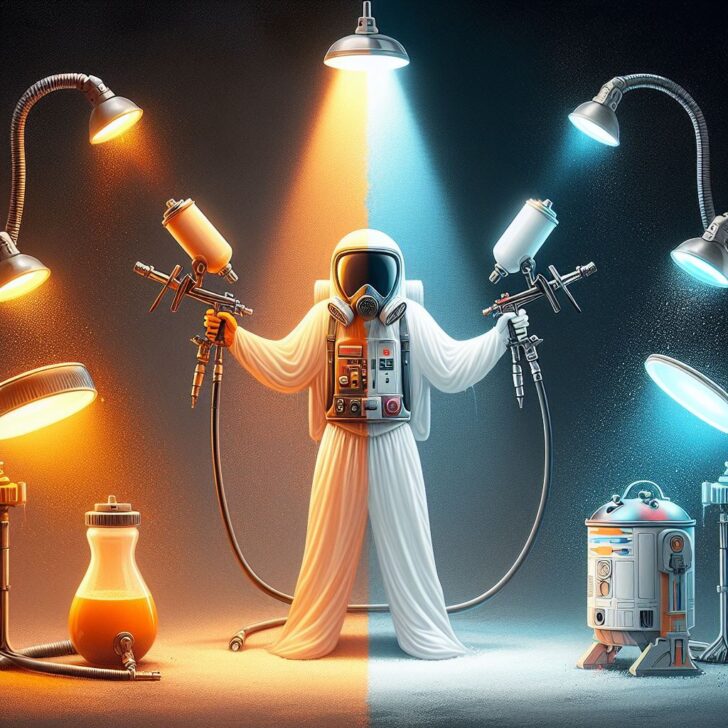When it comes to spray painting, choosing the right spray gun technology is crucial for achieving optimal results. HVLP, LVLP, LVMP, and HTE are different types of spray gun technologies that offer distinct advantages and applications. In this article, we will explore each of these technologies, their characteristics, and the scenarios in which they are commonly used.
Post Contents
HVLP (High Volume Low Pressure)
HVLP spray guns operate with high volume, low pressure, making them efficient in transferring a large volume of paint with minimal overspray. The high volume of air helps atomize the paint particles, resulting in a fine finish. HVLP guns are known for their excellent transfer efficiency and are commonly used for automotive painting, furniture refinishing, and other applications where a high-quality finish is desired.
LVLP (Low Volume Low Pressure)
LVLP spray guns work with low volume, low pressure, providing a controlled and economical approach to spray painting. These guns require lower air pressure and less volume of paint, making them suitable for small-scale projects or situations where limited airflow is available. LVLP guns are popular for touch-up work, small surface areas, and projects that require precision and control.
LVMP (Low Volume Medium Pressure)
LVMP spray guns combine the advantages of both HVLP and conventional spray guns. They operate with lower volume and slightly higher pressure compared to HVLP, resulting in improved atomization and a balance between transfer efficiency and speed. LVMP guns are versatile and can be used for various applications, including automotive refinishing, woodworking, and general purpose spraying.
HTE (High Transfer Efficiency)
HTE spray guns are designed specifically for high transfer efficiency, maximizing the amount of paint that adheres to the surface being sprayed. These guns use a combination of high volume and medium pressure, allowing for greater coverage and less overspray. HTE technology is often utilized in industrial applications, such as large-scale painting projects, where productivity and efficiency are paramount.
Choosing the Right Spray Gun Technology
The choice of spray gun technology depends on several factors, including the project requirements, desired finish quality, and available equipment. Here are some considerations when selecting the appropriate spray gun technology:
- Project Scale: HVLP or LVMP guns are often the preferred choice for larger projects requiring a high-quality finish. LVLP guns are suitable for smaller-scale projects or touch-up work.
- Air Supply: If you have limited airflow or a smaller compressor, LVLP guns may be a better option as they require lower air pressure.
- Transfer Efficiency: If maximizing paint transfer efficiency is a priority, HTE spray guns are ideal, especially for industrial applications.
- Finishing Quality: HVLP guns are known for their fine finishes, making them suitable for applications where a smooth and professional appearance is essential.
- Versatility: If you need a spray gun that can handle various projects, LVMP guns offer a balanced approach and can be used in different applications.
Examples illustrating HVLP, LVLP, LVMP, and HTE spray guns:
HVLP (High Volume Low Pressure) Spray Gun:
- Example: DeVilbiss GTI Pro Lite HVLP Spray Gun
- Description: HVLP spray guns are designed to operate with a high volume of air at low pressure, typically around 10 psi (pounds per square inch) or lower. They are known for their efficiency in atomizing paint and delivering a high transfer efficiency, resulting in reduced overspray and material waste. HVLP spray guns are commonly used for automotive painting, furniture finishing, and other applications where a fine finish and precise control are desired.
LVLP (Low Volume Low Pressure) Spray Gun:
- Example: SATAjet 1000 K RP LVLP Spray Gun
- Description: LVLP spray guns operate with a lower volume of air and low pressure, typically between 5-10 psi. They are designed to deliver a fine atomization with less overspray and material consumption compared to conventional spray guns. LVLP spray guns are suitable for smaller painting projects, touch-ups, and applications where reduced overspray is desired.
LVMP (Low Volume Medium Pressure) Spray Gun:
- Example: Iwata LPH-80 LVMP Spray Gun
- Description: LVMP spray guns operate with a low volume of air at medium pressure, typically between 10-20 psi. They provide a balance between atomization efficiency and transfer efficiency, making them suitable for a wide range of painting tasks, including automotive refinishing, woodworking, and industrial coatings. LVMP spray guns offer better material transfer compared to conventional HVLP guns while still maintaining a low overspray level.
HTE (High Transfer Efficiency) Spray Gun:
- Example: Graco Edge II Plus HTE Gun
- Description: HTE spray guns are designed to maximize material transfer efficiency while minimizing overspray and waste. They achieve this by optimizing the air and fluid dynamics to deliver a high transfer rate of paint onto the surface being sprayed. HTE spray guns are commonly used in industrial applications, automotive refinishing, and large-scale painting projects where efficiency and productivity are critical.
In summary, HVLP, LVLP, LVMP, and HTE spray guns differ in their air and fluid delivery systems, pressure levels, and transfer efficiency characteristics, making them suitable for various painting applications ranging from automotive refinishing to furniture finishing and industrial coatings.
Conclusion
Understanding the differences between HVLP, LVLP, LVMP, and HTE spray gun technologies is crucial for achieving optimal spray painting results. Each technology offers specific advantages in terms of transfer efficiency, finish quality, and versatility. By considering project requirements, air supply, and desired outcomes, you can select the most appropriate spray gun technology to meet your specific needs.
